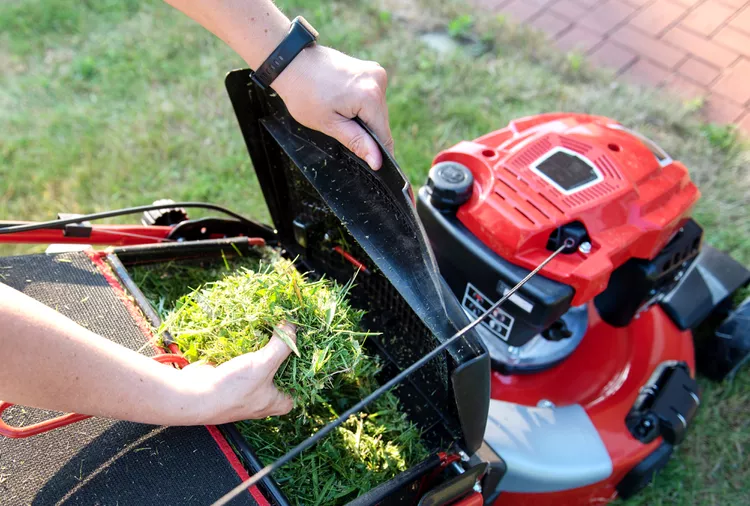Lawn aficionados—those who love to mow—tend to have strong opinions on whether it is best to mulch lawn clippings or bag them. While the mulching vs. bagging debate is dependent on several factors, there is one firm conclusion about lawn clippings that all turf scientists agree on: Clippings are rich in nutrients and should be recycled back into the landscape.
The science-based pros and cons presented here can help you decide whether to recycle clippings with a mulching mower or a bagging attachment. Use these pros and cons to choose the best tactic for your patch of grass.
Pros of Mulching Lawn Clippings
Mulching—when we’re talking about mowing—refers to returning lawn clippings to the turf. All lawnmowers can mulch clippings. Some mowers are designed to finely chop the clippings. These mowers are usually sold as mulching mowers, and they have an advantage over standard rotary mowers thanks to the ease of distributing the finely chopped clippings. The advantage is slight; in typical mowing conditions, a rotary mower and a mulching mower perform equally well.
Homeowners who mulch their lawn clippings benefit their grass in several ways.
Return Nutrients to the Turf
Clippings are rich in nitrogen and other valuable nutrients. As the clippings break down, the nutrients are released into the soil, where they are captured by plant roots. Returning clippings to the turf over a single season provides about 25 percent of the nitrogen a grass plant needs to grow well. This is equivalent to at least one fertilizer application per year.
Improve Soil Texture
As grass clippings decompose into the lawn, microbial activity improves the soil texture. New water and nutrient channels form, improving clay and sandy soils with the addition of organic matter. Over time, the soil improved by decomposing lawn clippings is more absorbent and well-drained.
Increase Carbon Sequestration
Lawns capture carbon. By returning carbon-laden clippings to the turf, the carbon is quickly reabsorbed and sequestered, reducing the amount of carbon dioxide in the atmosphere. Turf scientists have found that recycling clippings into the lawn increased the net carbon sequestration of a lawn by 11 to 59 percent over removing clippings.
Save Time and Labor
Mulching clippings is easy! The lawn mower does all the work. There is no need to heave bagged clippings into a compost bin or scatter them over open soil. Mulching clippings eliminates the need to find a municipal disposal method if composting isn’t an option.
Cons of Mulching Lawn Clippings
Excessively long clippings can pile up on the lawn, shading the grass that is trying to grow beneath. In extreme cases, the piles of clippings can smother turf. A rule of thumb is that clippings 1 inch in length can be safely returned to the lawn. Clippings longer than an inch should be collected and added to the compost pile or used as mulch in the landscape.
Myth: Clippings Cause Thatch
Clippings have a bad reputation for piling up between the soil surface and the actively growing grass plants to create a layer of thatch. Turf scientists have found that clippings decompose so quickly they don’t have a chance to accumulate. Clippings break down rapidly, sending the valuable nutrients they contain into the soil.
Many homeowners have heard that mulching clippings contributes to thatch buildup in a lawn, but that concern is overstated. Thatch can be caused by too much nitrogen fertilizer and infrequent mowing. It is also more common on compacted soils and with some grass varieties.
Bottom line: Clippings don’t cause thatch.
Pros of Bagging Clippings
There are real benefits to bagging clippings. When cutting long grass, bagging clippings prevents them from smothering the turf. Bagged grass clippings are useful as mulch in the landscape; spread a 2-inch-thick layer of clippings over soil to prevent weeds. Bagged clippings are also useful in a compost pile where they decompose along with brown matter, such as dried leaves, to make humus that will enrich the soil. Bagging clippings prevents them from littering walkways and clogging drains. Smart mowing tactics can eliminate clipping litter, too.
Cons of Bagging Clippings
Bagging clippings removes a valuable source of nitrogen from the lawn. Twenty-five percent of turf’s nitrogen needs can be met through mulching clippings back into the lawn. Bagging clippings becomes costly when you factor in the fertilizer needed to offset the lost nitrogen.
Bagging clippings is more time-consuming and labor-intensive than mulching. A full bag of clippings, especially wet clippings, is heavy; disposing of clippings in a compost pile requires strength. If you don’t have a compost area or use for the clippings in the landscape, you’re faced with the challenge of finding a way to dispose of them. Some municipalities accept yard waste; others do not.
Final Word: Mulching vs. Bagging
When possible, mulch clippings back into the lawn. The soil benefits of mulching and the nutrient boost provided by the clippings make this option the winner in almost all circumstances. From a practical time and labor standpoint, mulching clippings is easier and faster. The mower does the work, and your lawn reaps the benefits.




















